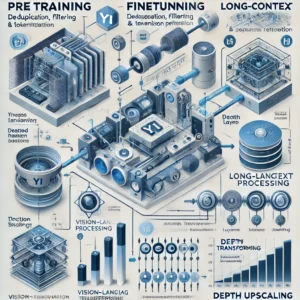In the evolving domain of artificial intelligence, the Qwen2.5 series by the Qwen Team represents a significant leap forward. Designed to cater to diverse needs, Qwen2.5 showcases a blend of powerful performance, scalability, and efficiency. With improvements in pretraining, post-training, and architecture, it stands as a competitive alternative to models like Llama-3 and GPT-4.
Here’s everything you need to know about Qwen2.5 and why it’s a game-changer.
What Makes Qwen2.5 Special?
Qwen2.5 isn’t just an upgrade; it’s a complete reimagination of how large language models (LLMs) are designed, trained, and deployed. Here are its standout features:
- Diverse Configurations:
- Seven model sizes: 0.5B, 1.5B, 3B, 7B, 14B, 32B, and 72B parameters.
- Both base and instruction-tuned models available.
- Quantized versions for edge deployment.
- Expanded Data and Context:
- Pretrained on 18 trillion tokens (up from 7 trillion in Qwen2).
- Handles longer contexts with a maximum sequence length of up to 1 million tokens (for Qwen2.5-Turbo).
- Innovative Training Techniques:
- Multi-stage reinforcement learning (offline DPO and online GRPO).
- Enhanced supervised fine-tuning (SFT) with over 1 million high-quality samples.
- Cost-Effective Performance:
- Mixture-of-Experts (MoE) variants (Qwen2.5-Turbo and Qwen2.5-Plus) offer competitive results at lower computational costs.
Architecture and Tokenizer Enhancements
1. Advanced Transformer Design
The dense Qwen2.5 models maintain a transformer-based decoder architecture while integrating:
- Grouped Query Attention (GQA): Reduces memory usage for inference.
- SwiGLU Activation Function: Ensures computational efficiency.
- Rotary Positional Embedding (RoPE): Optimized for extended sequences.
For MoE models, the standard feed-forward layers are replaced with specialized expert layers that dynamically route tokens, significantly improving efficiency.
2. Unified Tokenization
Qwen2.5 introduces an expanded tokenizer with a 151,643-token vocabulary. This ensures:
- Enhanced support for structured data (e.g., JSON, tables).
- Consistency across all model sizes.
Pretraining: Laying a Strong Foundation
Data Quality and Diversity
Qwen2.5’s pretraining dataset spans domains such as mathematics, coding, science, and general knowledge. The focus is on:
- Rigorous Filtering: Advanced techniques to retain only high-quality multilingual data.
- Domain Balance: Underrepresented areas like academic research are upsampled, while redundant content is downsampled.
Hyperparameter Scaling
The model leverages extensive scaling laws to optimize hyperparameters like batch size and learning rate. These adjustments ensure efficient training across all model sizes.
Long-Context Learning
Innovative techniques such as Dual Chunk Attention and YARN allow Qwen2.5 models to process sequences far beyond traditional limits. This is particularly beneficial for applications like document summarization and complex reasoning.
Post-Training: Elevating Model Performance
1. Supervised Fine-Tuning (SFT)
Qwen2.5 addresses specific challenges like long-sequence generation, coding, and structured data understanding. Highlights include:
- Mathematics and Coding: Chain-of-thought reasoning for mathematical problems and collaborative frameworks for multilingual code generation.
- Instruction Following: Rigorous validation ensures high adherence to user prompts.
2. Reinforcement Learning (RL)
Qwen2.5 employs a two-stage RL framework:
- Offline RL: Focused on challenging domains like reasoning and factuality.
- Online RL: Enhances truthfulness, relevance, and safety through dynamic feedback loops.
Performance Across Benchmarks
Qwen2.5 models outperform many industry leaders, delivering state-of-the-art results in:
- General Tasks: High scores in benchmarks like MMLU and ARC-C.
- Mathematics and Coding: Exceptional results in GSM8K and HumanEval.
- Multilingual Capabilities: Leading performance across languages in MMLU-based evaluations.
Notably, the flagship Qwen2.5-72B-Instruct rivals much larger models like Llama-3-405B, achieving similar performance at one-fifth the parameter size.
Real-World Applications
Qwen2.5’s versatility makes it a go-to solution for diverse use cases:
- Enterprise Chatbots: Handling extended conversations seamlessly.
- Educational Tools: Supporting advanced reasoning and problem-solving.
- Multilingual Communication: Bridging language gaps with precision.
The MoE variants, Qwen2.5-Turbo and Qwen2.5-Plus, cater to resource-constrained environments, offering cost-effective alternatives without compromising quality.
Looking Ahead
With Qwen2.5, the Qwen Team has set a new standard in open-weight large language models. Its blend of scalability, efficiency, and performance paves the way for broader accessibility and innovation in AI.
Whether you’re a researcher, developer, or enterprise, Qwen2.5 is poised to redefine what’s possible with LLMs. To explore the models, visit Hugging Face or ModelScope.






Be First to Comment